What's In a Name? 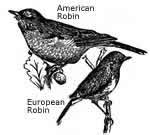 When the first European colonists came to the New World, they encountered many animals that they had never seen before and that they didn't have names for. They needed to come up with names for all these new animals! In some cases, they named the new animals they encountered after animals that were similar from their home country. For example, the American robin was named for the European robin which also has a red-breast. In other cases, they gave the new animals they encountered descriptive names like rattlesnake, bluebird, and white-tailed deer! When the first European colonists came to the New World, they encountered many animals that they had never seen before and that they didn't have names for. They needed to come up with names for all these new animals! In some cases, they named the new animals they encountered after animals that were similar from their home country. For example, the American robin was named for the European robin which also has a red-breast. In other cases, they gave the new animals they encountered descriptive names like rattlesnake, bluebird, and white-tailed deer!
Native Names 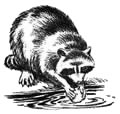 Occasionally, the settlers adopted and adapted Native American names for the new wildlife they encountered. Occasionally, the settlers adopted and adapted Native American names for the new wildlife they encountered.
 Moose comes from the from the Eastern Abenaki moos which means "strips bark from trees." Moose comes from the from the Eastern Abenaki moos which means "strips bark from trees."
 Raccoon comes from Virginia Algonquian arocoun and means "he scratches with the hands." Raccoon comes from Virginia Algonquian arocoun and means "he scratches with the hands."
 Skunk comes from the Algonquian seganku, which means "he who squirts." Skunk comes from the Algonquian seganku, which means "he who squirts."
 Opossum comes from the
Powhatan apasum and means "white animal." Opossum comes from the
Powhatan apasum and means "white animal."
 Caribou comes from the
Micmac kaleboo and means "pawer, scratcher." Caribou comes from the
Micmac kaleboo and means "pawer, scratcher."
 Chipmunk comes rom the
Algonquian Ojibwa atchitamon and means "one who descends trees headlong." Chipmunk comes rom the
Algonquian Ojibwa atchitamon and means "one who descends trees headlong." Talking Turkey 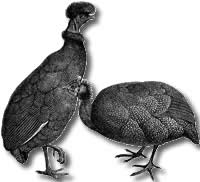 How did the wild turkey get its name? It is native to North America, so the early European settlers had never seen it before. How did a North American bird get the name of a country in the Old World? How did the wild turkey get its name? It is native to North America, so the early European settlers had never seen it before. How did a North American bird get the name of a country in the Old World?
The turkey was similar in looks to the guinea-fowl. The guinea-fowl is native to Africa, but it was brought to Europe from Turkey and was therefore sometimes called a turkey. So when the first European settlers saw the wild turkey, they named it after a bird they were already familiar with!
| | | |
Wild New England 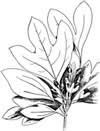 In 1603, Martin Pring of Bristol, England sailed off the coastline of New England in search of sassafras, which was valued for its medicinal properties. On his voyage he sailed down the Piscataqua River. He described the wildlife of the region as follows: In 1603, Martin Pring of Bristol, England sailed off the coastline of New England in search of sassafras, which was valued for its medicinal properties. On his voyage he sailed down the Piscataqua River. He described the wildlife of the region as follows:
"The Beasts here are Stags, fallow Deere in abundance, Beares, Wolves, Foxes, Lusernes, and (some say) Tygres, Porcupines, and Dogges with sharp and long noses, with many other sorts of wild beasts.
The most usuall Fowles are Eagles, Vultures, Hawks, Cranes, Herons, Crowes, Gulls, and great store of other River and Sea-fowles. And as the land is full of Gods good blessings, so is the Sea replenished with great abundance of excellent fish, as Cods sufficient to lade many ships, which we found upon the coast in the month of June, Seales to make Oile withall, Mullets, Turbuts, Mackerels, Herrings, Crabs, Lobsters, Creuises and Muscles with ragged Peales in them."
The Voyage of Martin Pring, 1603 |
Raccoon Encounter 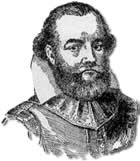 Captain John Smith provided the first English written reference to the raccoon in 1608 when he referred to raccoons as "Rahaugheums." He wrote of an encounter with the head of a tribe: Captain John Smith provided the first English written reference to the raccoon in 1608 when he referred to raccoons as "Rahaugheums." He wrote of an encounter with the head of a tribe:
"Arriving at Weramocomoco, their Emperour proudly lying uppon a Bedstead a foote high, upon tenne or twelve Mattes, richly hung with manie Chaynes of great Pearles about his necke, and covered with a great covering of Rahaugheums."
A True Relation by Captain John Smith, 1608 |
As you can see from this, raccoon was not the only word that evolved over time!
Captain Smith wrote again of the raccoon and other animals a few years later:
"There is a beast they call Aroughcun, much like a badger, but useth to live in trees as Squirrels doe. Their squirrels some are neare as greate as our smallest sort of wilde rabbits; some blackish or blacke and white but the most are gray.
A small beast they have, they call the Assapanick, but we call them flying squirrels, because spreading their legs, and so stretching the largenesse of their skins that they have been seen to fly 30 or 40 yards. An Opassom hath a head like a Swine, and a taile like a Rat, and is of the bignes of a Cat. Under her belly shee hath a bagge, wherein she lodgeth, carrieth, and sucketh her young. Mussascus is a beast of the forme and nature of our water Rats, but many of them smell exceeding strongly of muske."
A Map of Virginia: With a Description of the Country, the Commodities, People, Government and Religion, 1612 |
|

 When the first European colonists came to the New World, they encountered many animals that they had never seen before and that they didn't have names for. They needed to come up with names for all these new animals! In some cases, they named the new animals they encountered after animals that were similar from their home country. For example, the
When the first European colonists came to the New World, they encountered many animals that they had never seen before and that they didn't have names for. They needed to come up with names for all these new animals! In some cases, they named the new animals they encountered after animals that were similar from their home country. For example, the  Occasionally, the settlers adopted and adapted Native American names for the new wildlife they encountered.
Occasionally, the settlers adopted and adapted Native American names for the new wildlife they encountered.  How did the
How did the  In 1603, Martin Pring of Bristol, England sailed off the coastline of New England in search of sassafras, which was valued for its medicinal properties. On his voyage he sailed down the Piscataqua River. He described the wildlife of the region as follows:
In 1603, Martin Pring of Bristol, England sailed off the coastline of New England in search of sassafras, which was valued for its medicinal properties. On his voyage he sailed down the Piscataqua River. He described the wildlife of the region as follows: Captain John Smith provided the first English written reference to the raccoon in 1608 when he referred to raccoons as "Rahaugheums." He wrote of an encounter with the head of a tribe:
Captain John Smith provided the first English written reference to the raccoon in 1608 when he referred to raccoons as "Rahaugheums." He wrote of an encounter with the head of a tribe: